How to Dispose of a Refrigerator
Need to get rid of an old refrigerator but don't know what to do? Check out our comprehensive guide for refrigerator disposal and recycling options.
Check available dumpsters near you

Refrigerator Disposal Options for Any Home Project
Refrigerators are a household staple, which is why it’s a big deal when they break or overstay their welcome. Whether you are preparing for a move, decluttering a garage or demolishing an entire kitchen, learn how to get rid of a refrigerator properly. Donate or recycle your outdated refrigerator or simply toss a broken fridge or mini fridge — it’s entirely up to you.
Check out the details below to see which hassle-free disposal or recycling method works best for you.
Rent dumpsters often? Learn more about our residential services.
Refrigerator Door Removal Law
If you intend to recycle or dispose of a refrigerator, you’re required by law to first remove the doors. The Refrigerator Safety Act prohibits discarding a refrigerator without removing its doors because it poses risks to the environment, creates issues in landfills and most notably, becomes a hazard to children.
The U.S. Consumer Product Safety Commission warns that older refrigerator models can trap young children, so please tie the doors shut even if you are preparing to sell or donate it.

1. Sell It Online
There's a great market for purchasing used appliances, and outdated refrigerators are a hot item. Consider having a garage sale or researching local businesses that sell used refrigerators. You can also list your refrigerator online with the following marketplaces:
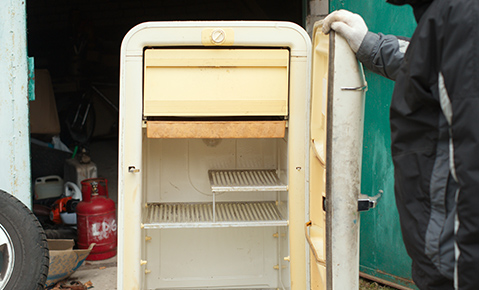
Tips for Selling a Refrigerator Online
Research Prices
Take a look at what your refrigerator’s make and model is selling for online on average. Call local shops to get an estimate of what they’d buy or sell a refrigerator for. It’s also helpful to see what the newest model costs so you know what reasonable price to charge.
Measurement Details
Include the height, width and depth of your refrigerator or mini fridge. If you no longer have the manual, find the specs online or measure it yourself. Just be sure to be as accurate as possible so the buyer knows if it will fit in the desired space — often, this is a tight squeeze.
Take Clear Pictures
Photograph the refrigerator from all sides, including the inside. Zoom in on any blemishes, markups or dents, and be honest about them in the listing so the buyer knows exactly what to expect.
Know Your Specs
Features of your fridge will go a long way to determining a price. Does it have vegetable crispers? Are the shelves adjustable? How many cold settings are available? No specification is too small to note.

2. Donate It
Donating an unwanted refrigerator is a useful option if you don’t want to deal with the extra effort of selling. This is a great way to help someone in need while simultaneously taking the fridge off your hands. Some organizations will even come pick up a refrigerator so you don’t have to handle it yourself. Contact your local non-profit to see if they’ll accept a gently used refrigerator or freezer, or reach out to one of these national donation centers:

Pro Tip
Some donation centers have limitations on how old a refrigerator can be before they’ll accept it. For this reason, it’s a good idea to call ahead and ensure they’ll take it before drop-off.
3. Find a Local Refrigerator Recycler
Did you know refrigerators can be recycled? Whether it’s reused for parts or refurbished for resale, recycling companies take broken refrigerators. Some will even pay you a nominal amount and pick up the appliance so you don’t have to worry about transporting it. Start researching programs near you with Energy Star's Find a Fridge or Freezer Recycling Program.

Refrigerator Recycling Tips
Contact Local Recycling Companies
Reach out to local companies with the general make and model, year and when you hope to drop it off to ensure they can accommodate your request.
Prepare for Transportation
Secure the door shut with rope or tape. It’s a good idea to wrap the appliance in bubble wrap or a moving blanket to protect it and your vehicle when driving. Refrigerators travel best standing up, so make sure it’s securely tied to your truck or trailer. Also, consider removing and securing removable shelves so they don’t break en-route.

Pro Tip
Check with your recycler first to see if they will handle Freon removal or if you’ll need to take care of that yourself.
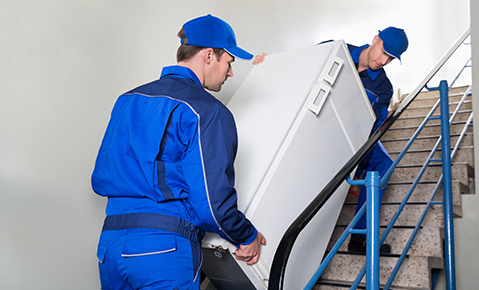
4. Hire a Junk Removal Service
Hiring a junk removal company can solve the issue of carrying or dismantling the refrigerator yourself. Their team will come inside your home and remove the fridge or freezer so you don’t have to deal with it. However, expect this to cost you anywhere from $100 to $600, depending on the time it takes, amount of appliances that need to go and employees required to get the job done.

Pro Tip
If none of the above options work for you, or your fridge is broken beyond repair, remember to remove the doors and remove the freon before moving forward with the following fridge disposal options.
5. Curbside Collection
Bulk pickup may be an option for you if your city accepts large appliances for disposal. Most do not, and those that do require you to set it out no sooner than the day of pickup. Keep in mind you need to drain the Freon, secure the doors shut or remove them altogether for safe and proper pickup. Otherwise, you risk the city leaving your refrigerator behind.
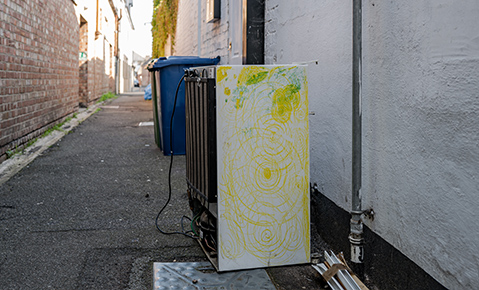

6. Rent a Dumpster
A residential dumpster rental can be a convenient way to get rid of a refrigerator, especially if you’re tackling a large-scale cleanout. Rather than dealing with the hassle of curbside collection, get a roll off dumpster so you can load it all on your timeline. You’ll know exactly what you owe upfront, and you don’t have to be there when the bin arrives, unlike with a junk removal team.

Pro Tip
When disposing of a mini fridge, make sure you drain the Freon like you would a full-sized refrigerator or freezer. Mini fridges contain insulation and refrigerants that are toxic if left inside the appliance and unlawfully thrown away.
Order a Dumpster Online
Shopping after hours? Too busy to make another call? Book the dumpster you need, when you need it. Order your dumpster online 24/7.

How to Get Rid of a Freezer
Similar to refrigerators, freezer disposal requires you to think ahead. Unplug the unit and open the lid to allow it to defrost overnight. Soak up any remaining water or moisture so it doesn’t leak when you move it. Then, if you’re tossing or recycling your freezer, carefully drain the Freon or enlist the help of a professional.
Lastly, take off the freezer door or lid by removing the lower hinge covers on the back — depending on your model, they should just pop out — while it’s shut. Open the lid and remove the upper lid covers. Lower the lid again, then take out the top screws with a screwdriver. Move the lid slightly ajar so there’s space to remove the hinge spacers. Now lift the door off and set it aside.
If you plan to sell or donate your working freezer, now is the time to clean it. Use a household cleaning product or mix one tablespoon of liquid chlorine bleach per gallon of water to kill any bacteria and odors left behind. Secure the freezer lid or door shut with a rope or tape when you’re finished. This way, it’s safe for transportation.

Safety Tip
If you’re in a hurry, don’t use a sharp object to chip the ice away or you’ll risk damaging the freezer, or worse, puncturing the freon gas line. Use a wooden spatula or similar blunt tool instead, and run a fan to speed up the process.
Tossing More Appliances?
Choose an appliance for detailed disposal options.
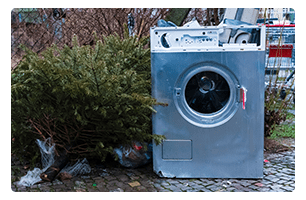 Washer & Dryer Washer & Dryer |
 Air Conditioner Air Conditioner |
 Dishwasher Dishwasher |
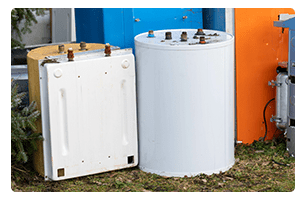 Water Heater Water Heater |
 Stove & Oven Stove & Oven |
 Microwave Microwave |
 Other Small Appliances Other Small Appliances |
Refrigerator Disposal FAQs:
Do you have to remove refrigerator doors?
Yes, according to the Refrigerator Safety Act, it’s against the law to leave the refrigerator doors attached for disposal. Leaving the doors on is a serious safety concern, and it creates unnecessary build-up at landfills.
Can you recycle a refrigerator?
Yes, many recyclers accept large appliances, like refrigerators and freezers. Find a local recycling center near you to learn more.
Are there free refrigerator disposal options?
Certain donation centers or energy companies, like FirstEnergy, will pick up your refrigerator for free. If you decide to sell a refrigerator, you can ask a local buyer to haul it away for you.
How to Remove Refrigerator Doors
With just a few tools and time, learn how to remove refrigerator doors yourself for safe and legal disposal.
Prep for Removal
First, disconnect the water line (if applicable) and electrical cable by referring to the model’s manual or following online instructions on the manufacturer’s website. With refrigerators that have ice makers, you can try accessing the water line by removing the front grill. Just note that certain models, like Whirlpool, require you to have the doors open before removal.
To access the electrical cable for the ice maker, it will either be beside the water line or underneath the top hinge cap. Unscrew and remove the cap, then pull the connector apart to disconnect.
Take Doors Off
Grab a socket wrench, Allen wrench or Phillips screwdriver, depending on your refrigerator model. Unscrew and remove the hinge bracket on the top of the door. Then, do the same with the screws — there are usually three. Now, take off the bracket and feed the electrical cable through as you lift. Repeat with the other door, if applicable.
You can now pick up and move the door freely away from the bottom pivot.
Storing the Doors
It’s a good idea to already have a place in mind to store the refrigerator and doors if you aren’t ready to drive them straight to a recycling center or toss them in a dumpster. Due to the weight of the doors and potential hazard for falling, put a towel down and let the doors rest directly on the floor.

Safety Tip
Refrigerator doors are heavy and awkward to handle. Make sure you have an area already prepped to put the doors that’s out-of-the-way, and enlist a friend or family member’s help to carry it.
More Debris Removal Resources
Getting rid of more than just a refrigerator? We’ll take you through the disposal process for common unwanted items. Check out our simple disposal guides, useful articles and blog posts to learn more.

Project Tutorials:
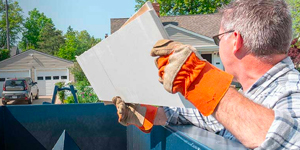
Dumpster Rental Tips:
